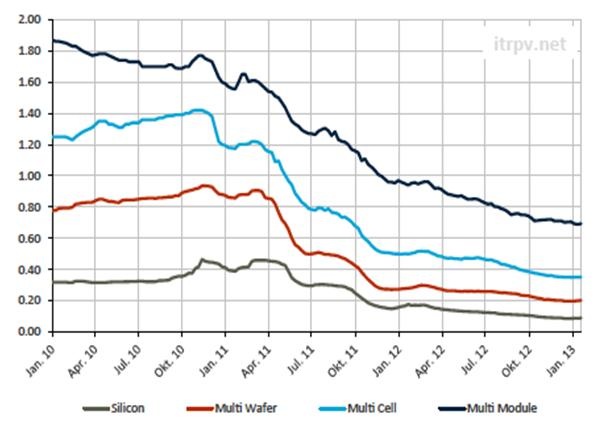Stemming a race to the bottom
The theme that seems to seep through in the Solar 2013 conference being held in Melbourne is of an industry trying to stem a possible race to the bottom. With the solar market internationally and in Australia going through a contraction and consolidation phase, there is a strong temptation for the weaker firms to compromise on quality in a bid to undercut on price. The long-term players in the industry know that you get what you pay for. But they face a challenge in that, at least right now, customers haven’t come to the same realisation, and there’s plenty of short-sighted competitors happy to exploit customers’ blissful ignorance.
At the very top-end of the chain there was Professor Stuart Wenham, Chief Technology Officer of Suntech and Director of UNSW’s Photovoltaic Centre of Excellence. Wenham outlined how, with the decline in prices for silicon, the major cost of solar panels increasingly lies in the assembling of the solar cells into a glass encapsulated module.

Production of silicon solar cells is a highly capital intensive business and the preserve of sophisticated, highly automated facilities with high levels of quality control. However all manner of firms can play in module assembly.
With module assembly now the predominant cost driver, there is greater temptation to cut corners in this area with serious consequences for the durability and long-term performance of panels. According to Wenham, the larger, branded Chinese producers just aren’t willing to do this, but the smaller players are. The smaller producers have little brand value to protect and many are in the process of exiting the industry anyway.
Damon Cole, Australian Commercial Director for Yingli (the world’s largest solar PV producer), is grappling with this challenge first hand in the Australian market. His presentation could be summed up as a rant against an Australian solar retailing industry that he says looks more like a bunch of Persian rug dealers engaged in a closing down sale, than providers of a sophisticated and revolutionary piece of energy technology.
As a result of primitive Crazy-John style marketing, Australian consumers have been trained to think all that matters is price and the level of the government rebate. Where quality is emphasised it usually relies on a linkage to any country other than China (something I touched on in a story about Chinese solar panels being sold under the brand Australian Solar Panel by a company calling itself Euro Solar).
One can imagine the frustration for Cole. Yingli is the world’s biggest producer of solar and has good quality control but consumers wouldn’t have a clue. In the end it’s made in China and carries an overtly Chinese brand name, so trying to command a premium over what he knows are inferior quality product is tough.
Then at the coal face there was Glen Morris of Solarquip, the person developing the standards and training for installers of solar and a solar installer himself. He sees first-hand the good, the bad, and the downright ugly in solar installations. According to Morris, there are plenty of very good installers and overall installation standards are improving. But there are some clear problems too.
Salespeople with no technical training are often the de-facto designers of solar systems. Their incentives are often to sell as many panels as possible, or just give the customer whatever they ask for, irrespective of whether this might be suitable to a customer’s roof space.
Also while all panels and system installations must meet Australian standards, there can still be very big differences in quality.
The industry faces a clear challenge – many customers don’t know the difference between good and bad. Thankfully the Australian Solar Council is aiming to address this. Morris outlined a series of endorsement labels that will distinguish businesses and panels that achieve high quality standards. This will be backed by random audits and commitment that this will not be an ‘everyone’s a winner’-style program. There are firms and panels that will not qualify. And endorsements are not set and forget. Firms will have to continually demonstrate high standards of performance or endorsements will be withdrawn.
Solar is highly regarded by the Australian community, but it cannot be taken for granted. The industry desperately needs a means of distinguishing the good from the bad. The endorsement label initiative from the Australian Solar Council is an important step forward.













